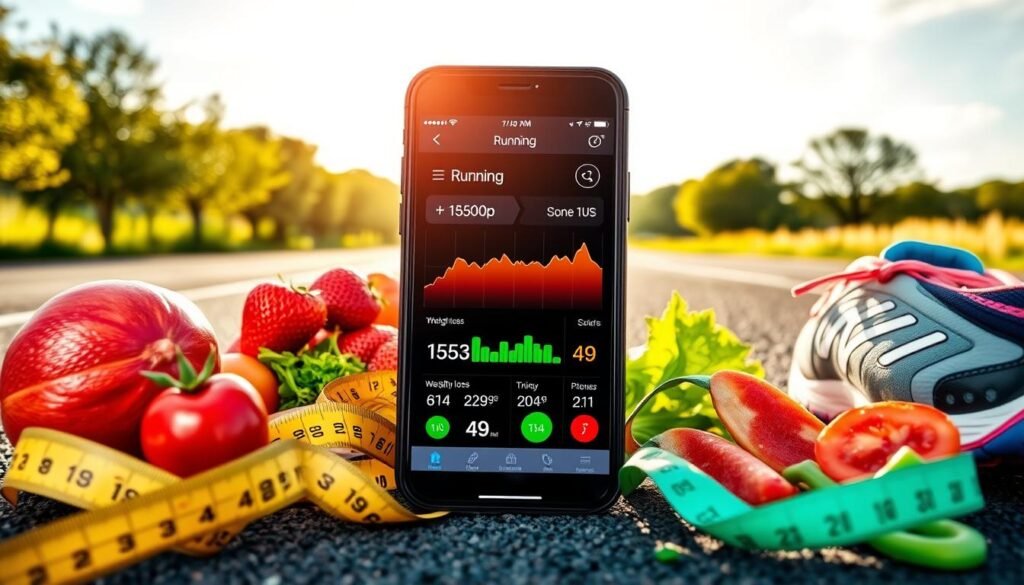When you put on your running shoes, it’s more than just a step towards losing weight. It’s about getting your health back, feeling more energetic, and living a life that makes you feel great. Running is not just a workout; it’s a way to change your body and mind. It helps you reach your dreams.
Key Takeaways
- Running is an efficient way to create a calorie deficit for weight loss, with an average of 100 calories burned per mile.
- Aim for a safe and sustainable weight loss rate of 1-2 pounds per week through a combination of diet and exercise.
- Consistency is key when using running for weight loss, as it helps maintain a calorie deficit over time.
- Incorporate strength training alongside your running routine to boost calorie burn and prevent injuries.
- Utilize high-intensity interval training (HIIT) to maximize fat burning and boost metabolism.
Understanding the Science Behind Running and Weight Loss
Running is a great way to lose weight. It burns calories during and after your workout. Knowing how running helps with weight loss can make it more effective.
How Caloric Deficit Works for Weight Loss
Weight loss happens when you burn more calories than you eat. Running helps you do this. Running about 100 calories per mile can help you lose weight.
The Role of Metabolism in Running
Your metabolism is key to losing weight. Running can increase your muscle mass. This means you burn more calories, even when you’re not moving.
Understanding Energy Expenditure During Exercise
The intensity of your run affects calorie burn. High-intensity interval training (HIIT) is very effective. It can burn calories for up to 48 hours after your workout.
| Workout | Calories Burned (30 minutes) |
|---|---|
| Running at 6 mph | 372 calories |
| HIIT Running | 450-600 calories |
Understanding running and weight loss can help you reach your fitness goals. Adding running to your routine, along with a healthy diet, can lead to lasting weight loss.
Getting Started: Essential Running Tips for Weight Loss
Starting a running journey for weight loss is exciting and rewarding. But, it’s important to do it slowly and steadily. Begin by building a regular running habit, not focusing too much on losing weight.
Start with short runs for beginners. As you get fitter, make your runs longer and harder. Good running form helps you run better and avoid injuries. Keep your posture right, land softly on your feet, and move your arms well.
Finding the right running shoes is key, even more so if you’re heavier. Go to a running store to get your gait checked. This ensures you get shoes that support and cushion your feet well.
- Be consistent with your running to see weight loss. Start by running and walking to build up your endurance.
- Focus on moving and burning calories, not just the numbers. The more you run, the more calories you’ll lose.
- Keep track of your food and calories burned with a journal or app. This helps balance your diet with your running workouts.
Remember, losing weight through running takes patience and regular effort. Stick to your routine, listen to your body, and celebrate your progress. With the right mindset, you’ll reach your weight loss goals through running.
Creating an Effective Running Schedule for Beginners
Creating a good running schedule is key for losing weight. It doesn’t matter if you’re new to running or have been doing it for years. A consistent routine is vital for your weight loss journey.
Building Mileage Safely
Start by slowly increasing your running distance. This helps avoid injuries and builds endurance. Try to run 3-4 times a week. Increase your distance by no more than 10% each week.
This slow increase helps your body adjust. It also prevents injuries from overuse.
Balancing Rest and Training Days
Rest days are just as important as running days. Make sure to take at least one or two rest days between runs. This lets your body recover and stay energized.
Resting helps prevent injuries. It also lets you enjoy the benefits of your runs more.
Progressive Training Principles
As you get more comfortable, try new things. Add interval training, hill repeats, or longer runs to your routine. This keeps your workouts interesting and challenging.
Increasing the intensity and duration of your runs boosts your fitness. It also helps with weight loss.
Shoot for 250 to 300 minutes of moderate exercise each week. This will help you lose weight effectively. By following these tips, you’ll create a running routine that supports your weight loss goals.
| Exercise | Calories Burned per Minute |
|---|---|
| Running | 13.2 |
| Swimming | 9.0 |
| Tennis | 6.9 |
| Biking | 6.4 |
Running burns the most calories per minute. This makes it a great choice for losing weight. By sticking to a good running schedule and pushing yourself, you’ll reach your fitness goals.
High-Intensity Running Workouts for Maximum Fat Burn
If you want to burn more fat while running, try high-intensity interval training (HIIT). HIIT mixes short, intense runs with rest periods. It burns calories faster than regular cardio.
Start with 20-minute HIIT runs. Run at 80-90% of your max heart rate. Sprint for 30-60 seconds, then rest for 1-2 minutes. Repeat this several times. As you get fitter, increase the sprint time and number of repeats.
Also, add longer, slower runs to your routine. Mixing HIIT with steady-state cardio boosts calorie burn even after you stop running.
| HIIT Benefits for Weight Loss | Traditional Steady-State Cardio |
|---|---|
|
|
Choose what you like best: HIIT, steady-state running, or both. Try different high-intensity interval training runs, calorie-burning running routines, and interval training to find what suits you best.
“Studies have shown that HIIT increases the level of growth hormones in your body after exercise, which can increase fat and calorie burn.”

Nutrition Strategies for Weight Loss Runners
As a runner looking to lose weight, your diet is key. Eating a balanced diet that helps you burn more calories is important. Focus on whole foods and control your portion sizes for lasting weight loss.
Pre-Run Fuel Options
Choose snacks with carbs, protein, and fats before running. Options like a banana with almond butter or whole-grain toast with eggs are great. Stay away from heavy, fatty foods that can slow you down.
Post-Run Recovery Meals
Refuel with carbs and protein within 30 minutes of running. A smoothie with Greek yogurt and berries or grilled chicken with quinoa are good choices. This helps your muscles recover and supports your weight loss.
Hydration Guidelines
- Drink water all day, not just when you run.
- Steer clear of sugary drinks that add calories.
- Check your urine color to see if you’re drinking enough water. Aim for light yellow to clear.
- Drink more water on hot or humid days and after long or hard runs.
By following these tips, you can fuel your body for better running and weight loss. Listen to your body and adjust your diet and hydration as needed. This will help you find the right balance for your needs.
| Nutrient | Recommended Daily Intake for Runners |
|---|---|
| Carbohydrates | 3-4 grams per kg of body weight |
| Protein | 1.8-2.7 grams per kg of body weight |
| Fat | 20-30% of total daily calorie intake |
Common Mistakes to Avoid When Running for Weight Loss
Running is a great way to lose weight, but there are pitfalls to watch out for. One big mistake is eating too much after a run. Remember, losing weight means burning more calories than you eat. So, keep an eye on your total calorie intake, even on days you run a lot.
Another mistake is only running to lose weight. Running is good for burning calories, but you also need strength training. Strength exercises help build muscle, which boosts your metabolism and helps you lose weight better.
- Don’t run on an empty stomach. It can make your workouts shorter and less effective. Eat a balanced snack before running to have enough energy.
- Don’t forget rest and recovery days. Too much running can lead to burnout, injury, and less results. Make sure to rest enough between runs to let your body heal and recharge.
- Don’t increase your running too fast. It can lead to injury. Start slow and gradually increase your running to let your body adapt.
- Don’t skip strength training. It’s important for preventing injuries and burning more calories. Add strength exercises to your routine to support your running and get a leaner body.
By avoiding these mistakes, you can use running to lose weight effectively. Remember, losing weight takes time and consistency. Stay patient and keep working towards your fitness goals.
| Statistic | Value |
|---|---|
| Running burns more calories per minute of exercise than almost any other aerobic activity. | – |
| People who run just 6.1 miles (10 kilometers) per week tend to have lower body weight and body fat percentages than non-runners. | – |
| High-intensity running burns approximately 965 calories per hour for a 185-pound athlete, significantly more than cycling, circuit training, rowing, swimming, jogging, or hiking. | – |
| Studies have shown that running for just 30 minutes regularly can lead to excellent weight loss benefits. | – |
| A weekly running distance of as little as 5 kilometers (a little over 3 miles) has been associated with weight loss. | – |
| Incorporating strength training in a running routine can help build lean muscle mass and boost metabolism, contributing to sustained weight loss. | – |
| Following a structured running plan, including intervals and strength training, helps increase motivation and ensure gradual progress. | – |
| Running three to four times a week is a good starting point for weight loss. | – |
| On average, running can help burn about 100 calories per mile or up to 500 calories per 30 minutes. | – |
| High-intensity cardio, such as running, has been shown to target belly fat, aiding in achieving a slimmer waistline when done regularly. | – |
By avoiding these common mistakes and following a well-rounded approach that combines running, strength training, and proper nutrition, you’ll be on the path to successful and sustainable weight loss through your running workouts.
Combining Strength Training with Running
Adding strength training to your running routine can boost weight loss and performance. It also helps prevent injuries. Just 2-3 strength training sessions a week can offer great benefits.
Essential Exercises for Runners
Focus on exercises that strengthen your legs, core, and hips. These are key for runners. Some must-do exercises include:
- Squats
- Lunges
- Deadlifts
- Planks
- Hip Bridges
These exercises work many muscles at once. This boosts your overall strength and power for running.
Weekly Strength Training Schedule
Runners should aim for 3 longer and 2 shorter strength training sessions a week. This mix helps muscles recover while staying strong. Always follow the 80/20 rule for easy and hard days in both running and weightlifting.
Injury Prevention Tips
Strength training is key to preventing injuries in runners. It strengthens muscles, tendons, and joints. This makes you more resilient to running’s impact.
Plyometric exercises and HIIT running workouts also boost metabolism and fat loss. Finding the right balance between running, strength training, and rest is essential. Listen to your body and adjust your training to avoid overtraining.
Tracking Progress and Measuring Success
Reaching your weight loss goals through running is more than just weighing yourself. It’s important to use different ways to see how you’re changing. By looking at more than just the scale, you can really understand how your body is changing.
Measuring your body fat percentage is a good way to track your progress. It’s more accurate than BMI for some people. You can use a body fat scale or calipers to see how your body shape and muscle-to-fat ratio are changing.
Also, notice how your clothes fit. As you lose weight and build muscle, your clothes might fit better or even be too loose. These small changes can show how much you’ve lost weight.
- Use running apps to track your runs, pace, and calories burned. This helps you see how you’re doing and set goals.
- Wear a fitness tracker to keep an eye on your heart rate and activity. It shows how well your cardio exercises for weight management are working.
- Set goals and celebrate your small wins. Getting better at running, like running farther or faster, is just as good as losing weight.
By looking at your progress in many ways, you’ll understand how your body is changing. This helps you make better choices for your running and weight loss plan. Remember, the journey is just as important as reaching your goal, so enjoy the progress you make along the way.

Conclusion
Running is a great way to lose weight if you eat right and do strength training too. Being consistent and progressive is key. Always keep your running form right and rest well to avoid injuries.
Adding running to your life, along with healthy eating and strength training, helps you lose weight. Keep track of your progress and change your routine if needed. This way, you’ll keep seeing results.
Running for weight loss is a long-term journey, not a quick fix. Stay committed, listen to your body, and enjoy the journey to being healthier and fitter. With a balanced approach and dedication, you can achieve lasting weight loss through running.





Nice read. I just passed this on to a friend who was doing a little research on that. And he just bought me lunch because I found it for him. Smile. Therefore, let me rephrase that: Thank you for lunch!